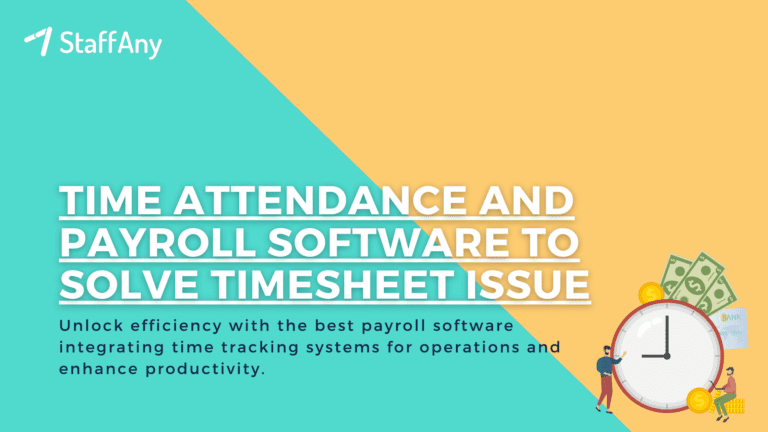Training restaurant employees is an essential component of running a successful restaurant. It’s not just about providing excellent food and service; it’s also about how to train restaurant staff to improve efficiency.
Properly training your restaurant staff can improve the quality of service, increase customer satisfaction, and boost staff morale.
In this article, we will discuss the importance of staff training for restaurants, what to include in your training plan, and seven tips to train restaurant staff to improve efficiency. Let’s find out below!
The Importance of Restaurant Staff Training

Restaurant staff training is of paramount importance for several reasons, as it directly impacts the overall success, reputation, and customer experience of a restaurant. Here are key reasons highlighting the importance of restaurant training:
1. Consistent Service Quality
Training ensures that all staff members understand and adhere to consistent standards of service. This consistency contributes to delivering a high-quality dining experience to every customer, regardless of when they visit or which staff members serve them.
2. Customer Satisfaction
Well-trained staff provide attentive, knowledgeable, and courteous service. Satisfied customers are more likely to return and recommend the restaurant to others, leading to increased business and revenue.
3. Enhanced Guest Experience
Properly trained staff create a positive and welcoming atmosphere that makes guests feel valued and appreciated. This experience encourages repeat visits and builds customer loyalty.
4. Effective Communication
Restaurant training program teaches staff how to communicate effectively with each other, guests, and management. Clear communication leads to smoother operations, fewer misunderstandings, and improved teamwork.
5. Efficiency and Productivity
Skilled staff can complete tasks more efficiently and effectively. Proper training reduces errors, minimizes wastage, and streamlines operations, ultimately increasing productivity.
Read more: Restaurant Management Plan: Benefits & Development
6. Upselling and Revenue Generation
Training equips staff with the knowledge and confidence to upsell menu items, special offers, and additional services. This contributes to higher average checks and increased revenue.
7. Adherence to Standards and Regulations
Training ensures that staff are aware of and follow industry regulations, health and safety protocols, and food handling guidelines. This promotes compliance and minimizes risks.
8. Quick Problem-Solving
Proper training prepares staff to handle challenges and unexpected situations, such as customer complaints, service disruptions, or equipment failures, without compromising service quality.
9. Employee Satisfaction and Retention
Training demonstrates the restaurant’s investment in its employees’ professional development. This fosters a positive work environment, boosts job satisfaction, and encourages staff to stay with the restaurant longer.
10. Reduced Turnover Costs
Well-trained staff are more likely to feel confident and capable in their roles, leading to lower turnover rates. Reduced turnover saves the restaurant recruitment, hiring, and training costs.
Read more: 11 Effective Restaurant Risk Management Strategies
11. Crisis Management
In emergencies, such as accidents or natural disasters, trained staff can respond quickly and appropriately to ensure the safety of guests and colleagues.
12. Menu Knowledge
Staff who understand the menu and ingredients can provide accurate information to customers, answer questions, and make appropriate recommendations, enhancing the dining experience.
13. Cross-Training and Flexibility
Cross-training staff in different roles prepares them to step in when needed, promoting operational flexibility and continuity in case of absences.
14. Positive Reputation
A well-trained staff delivers exceptional service and positive interactions, leading to favorable online reviews and word-of-mouth recommendations that contribute to the restaurant’s reputation.
15. Competitive Advantage
A restaurant with highly trained staff stands out from the competition, attracting discerning customers who value quality service and a memorable dining experience.
In summary, restaurant staff training is an investment that directly influences the restaurant’s reputation, customer satisfaction, operational efficiency, and financial success.
A well-trained team not only enhances the dining experience but also contributes to a positive work environment and long-term growth.
Read more: 8 Staff Schedule Management Tips for Business Owners
What to Include in Your Training Plan

Before starting your staff training, it’s essential to develop a comprehensive training plan. The training plan should cover all aspects of your restaurant’s operations, from customer service to food safety. Here are some items that you should include in your training plan:
1. Orientation
The first component of your training plan should be an orientation program that introduces new employees to your restaurant’s culture, values, and goals.
This can include information about your menu, the history of your restaurant, and your expectations for employee behaviour and performance. It is important to establish a positive tone and help employees feel welcomed and supported from the start.
2. Standard Operating Procedures
Standard operating procedures (SOPs) are a set of guidelines that outline the steps required to complete specific tasks.
Your training plan should include detailed SOPs for all aspects of your restaurant’s operations, from food preparation to customer service. Ensure your employee handbook is up-to-date.
These guidelines should be easy to follow and clearly communicated to employees. SOPs can help ensure that tasks are completed consistently and efficiently, reducing the risk of errors and delays.
Read more: 15 Employee Engagement Activities to Keep Them Motivated
3. The Training(s)
There are a lot of different types of training process that could be used for hospitality industry. You can also create your own by working with your experienced employees. Here are some common restaurant training programs:
a. Customer Service Training
Customer service training should cover how to greet customers, take orders, and handle complaints. With this training sessions, the staff will be trained to provide excellent customer service and ensure that customers leave satisfied.
b. Food Safety Training
Food and beverage training should cover how to prepare and serve food and drinks. With this training, the staff will be trained on how to handle food safely, how to make recommendations to customers, and how to pair food and drinks.
c. Health and Safety Training
Health and safety training should cover food hygiene, sanitation, and safety regulations. With this training, the staff will be trained on how to maintain a clean and safe working environment and how to prevent accidents.
d. POS and Payment System Training
POS and payment system training should cover how to operate the point of sale (POS) system and process payments. With this training, the staff will be trained on how to handle cash and card payments and how to troubleshoot common issues.
4. Teamwork and Communication
In a fast-paced environment like a restaurant, effective teamwork and communication are essential. Your training plan should include information on how to work collaboratively with others, how to communicate effectively with coworkers, and how to manage conflict and disagreements. This can help ensure that your staff works together smoothly and efficiently, providing excellent service to customers.
5. Technology
Technology is becoming increasingly important in the restaurant industry. Your training plan should include information on how to use any technology or software that your restaurant uses, such as point-of-sale systems, online ordering platforms, and reservation systems.
Providing training on technology can help ensure that your staff is comfortable and confident using these tools, reducing the risk of errors and delays.
Read more: Why Is Employee Engagement Important For Your Business?
7 Tips to Train Restaurant Staff to Improve Efficiency

Now that we have covered what to include in your training plan, let’s discuss some tips to train restaurant staff to improve efficiency.
1. Create a Structured Training Program
Create a structured training program that covers all the essential aspects of your restaurant’s operations. Use a mix of hands-on training and classroom-style instruction to ensure that your staff is equipped with the necessary skills and knowledge.
2. Use Visual Aids
Visual aids can help staff understand complex concepts and procedures. Use diagrams, flowcharts, and videos to demonstrate how to perform tasks such as food preparation and POS system operation.
3. Role-Playing Exercises
Role-playing exercises can help staff develop their customer service skills. For example, you can ask one employee to play the role of a difficult customer, while another employee practices handling the situation. This can help employees build their confidence and improve their ability to handle customer complaints effectively.
Read more: Understanding the Importance of Human Resource Planning
4. Provide Ongoing Training
Training should not be a one-time event. As your restaurant evolves, your training should also evolve. Provide ongoing training to keep your staff up-to-date with new products, procedures, and technology. This can help ensure that your staff is always prepared to provide excellent service to customers.
5. Offer Incentives
Offering incentives can be a great way to motivate your staff to engage in training. You can offer bonuses, promotions, or other rewards to employees who complete training programs successfully. This can help create a culture of learning and development within your restaurant.
Read more: Everything Business Owners Need to Know About Employee Benefits in Malaysia
6. Get Feedback
It’s essential to get feedback from your staff regarding their training. Ask for their input on what worked well and what could be improved. This can help you refine your training programs and ensure that your staff is getting the most out of the training.
7. Lead by Example
Finally, lead by example. As a manager or owner, it’s important to demonstrate the behaviours and skills that you want your staff to emulate. Be present in the restaurant, engage with customers, and be an active participant in training programs. This can help create a positive work environment and foster a culture of learning.
Read more: The Importance of Time Management for Restaurants, Cafes, and Other F&B Businesses
If you’re looking for a reliable and efficient way to track your restaurant staff’s hours, look no further than StaffAny’s online timesheet tracker.
With features like real-time clock-ins and outs, automatic overtime calculations, and customizable shift schedules, StaffAny makes it easy to manage your staff’s time and attendance. Visit StaffAny to get started!











